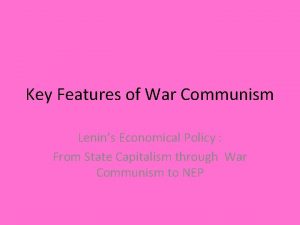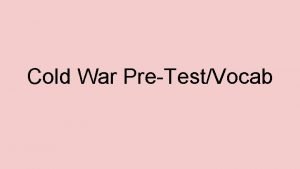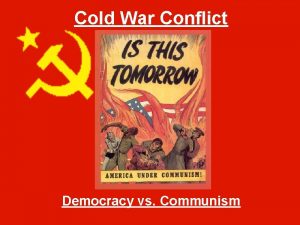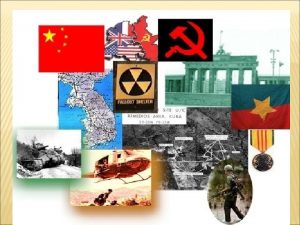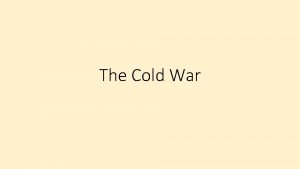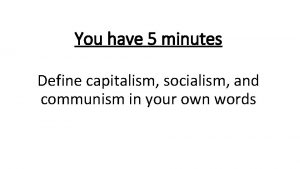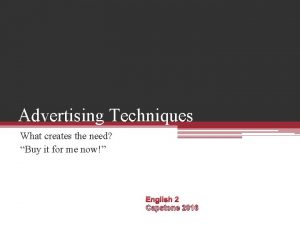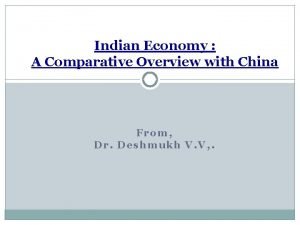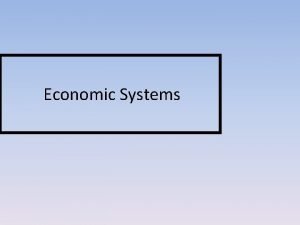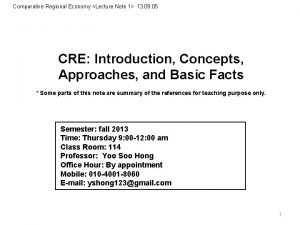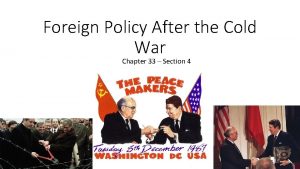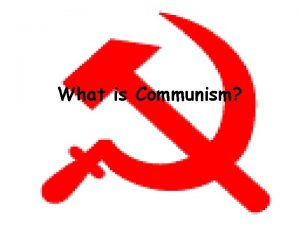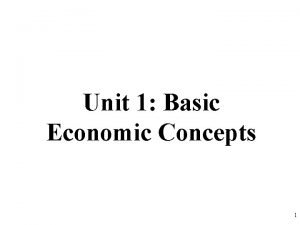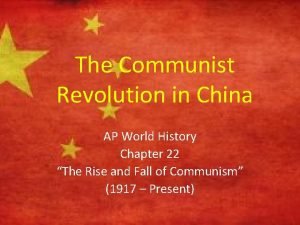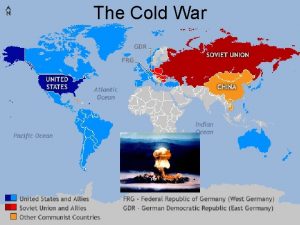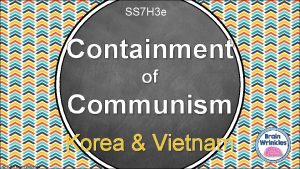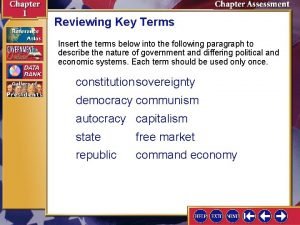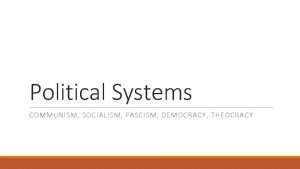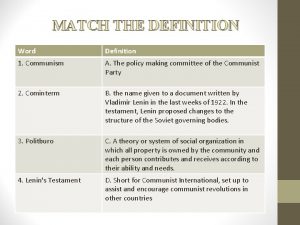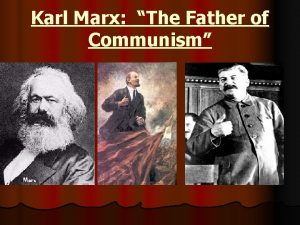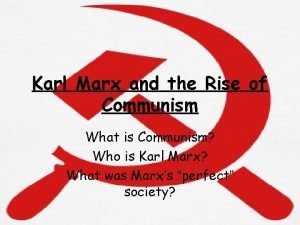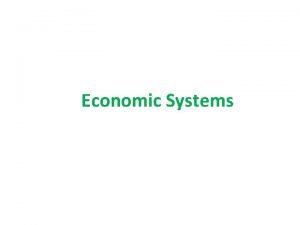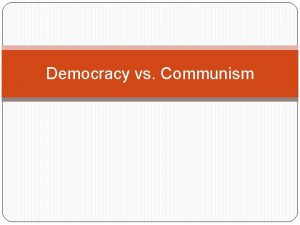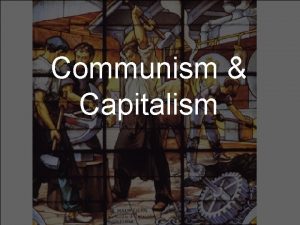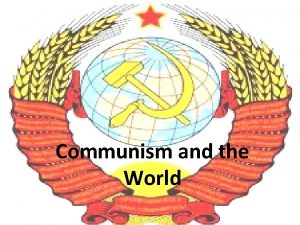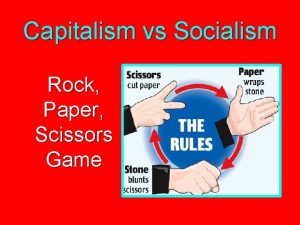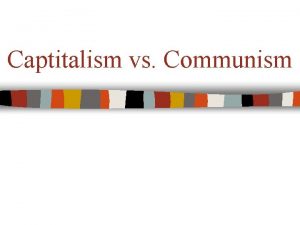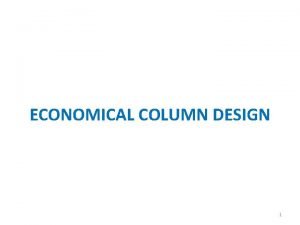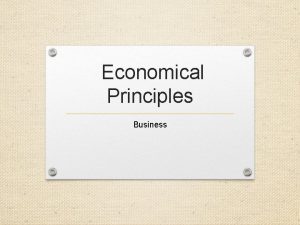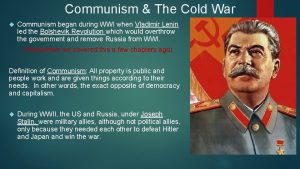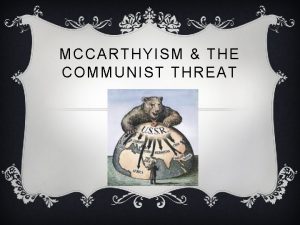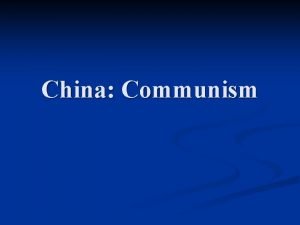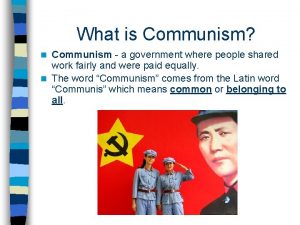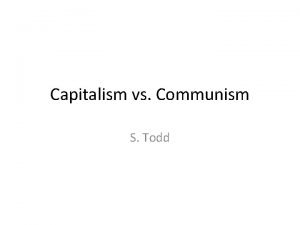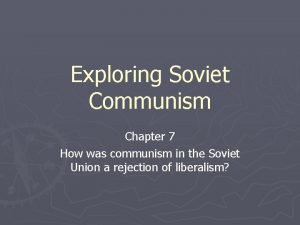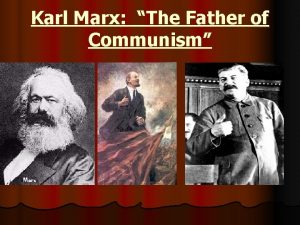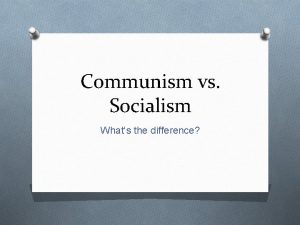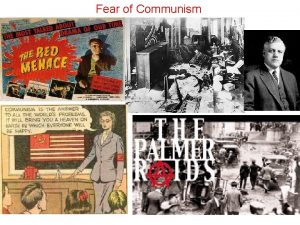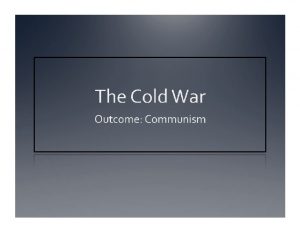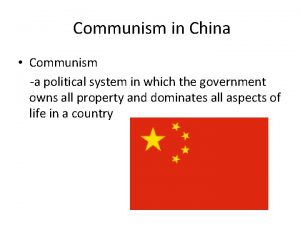Key Features of War Communism Lenins Economical Policy
















































- Slides: 48

Key Features of War Communism Lenin’s Economical Policy : From State Capitalism through War Communism to NEP

The tragedy of the Russian people • “We were always for revolutionary war. The bayonet is an essential necessity for introducing communism. ” • Karl Radek

Decrees 1 -3 • After the October Revolution the new Bolshevik government abolished private ownership of land began distributing it among the peasants. • Banks and large companies such as the Putilov Metal Works, were nationalized and workers control of factory production was introduced.

What is War Communism • During the Civil War the government decided to introduce what became known as War Communism. • All companies were now nationalized and the government now decided what should be produced. • The government also had the power to force men and women to work in certain industries. • Soldiers were also sent into rural areas to requisition grain and vegetables.

Siberia • The peasants responded to this by cutting down the sown area. • • There were also peasant risings in 1920 -1 in the Volga basin and Siberia

Collage on War Communism


Requisition Squads

Communist Film ( Propaganda 1956 )

Key Features of war Communism • All factories of any size were nationalized and the military discipline was applied to the factories. • Middle class managers, accountants and engineers were brought back to run the factories, most of which had been placed under workers’ control in the months after the revolution, usually with disastrous results -

Key Features of war Communism • Food and grain were seized from the peasants by Red Guards in order to feed the workers and the troops. • The old inflation-ridden currency was abandoned. • Instead wages were paid in food and fuel and trade was by barter.

Results of War Communism • The peasants decided it was not worth growing food for the Communists to take and so reduced their sowing. The result was a terrible food shortage, leading to possibly 7, 500, 000 deaths. • Food shortages in the towns led to large-scale migration from the cities; between 1917 and 1920 the urban population fell by 33%.

Effects

Results of War Communism • War Communism did not prevent a continuing fall in industrial and agricultural output; • By 1921 the grain harvest was only 50% of the 1913 level and industrial production had fallen to just 20% of the 1913 level. • However, the economic crisis was just as bad in the areas controlled by the Whites. • War Communism ensured that the Red Army was fed and equipped. - Means justify the ends ? • It took the majority of resources: e. g. 60% of food, and 70% of shoes.

Recollections ; Sally J. Taylor, the author of Stalin's Apologist: Walter Duranty • War Communism, came to rely more and more upon repression and outright violence as the main methods of securing meat and grain from the peasants. • Essentials like salt, kerosene, and matches were in short supply; important manufactured goods, such as boots and farming implements, were not forthcoming.

Recollections ; Sally J. Taylor, the author of Stalin's Apologist: Walter Duranty • With few rewards for their labour, the peasants showed little interest in growing more than what their immediate needs required. • Now a ruinous drought in the grain-growing districts added to the misfortunes of the already depleted countryside, and the entire nation lay exhausted, in a state of virtual collapse. "

Crises facing the Communist Party 1. The Krondstadt Rebellion (February-March 1921) • In February-March 1921, sailors at the naval base at Kronstadt, near Petrograd, revolted against the Communist Party, claiming that the Communists had broken all the promises that they had made to the Russian people and that the Cheka was arresting members of other socialist parties and stealing the peasants' crops. • Eventually the rising was crushed by the Red Army, with a huge loss of life. • The rebellion alarmed the Communist leadership because the Kronstadt sailors had been among their most committed supporters in 1917 and during the Civil War.



Crises facing the Communist Party 2. Rebellion in Tambov Province Peasants in Tambov rebelled and attacked and robbed grain convoys. 3. Widespread strikes Strikes occurred in 77% of Russia's large and medium-sized factories during 1920.


Economic Chaos and famine • Agricultural and industrial output had fallen drastically as a result of the Civil War and the losses incurred under the Treaty of Brest. Litovsk. • In excess of 7 million Russians died of famine and disease in 1921, leading Lenin to call on Red Cross for help.

The Establishment of Single Party Rule • Ever since the closure of the Constituent assembly in January 1918, it had been apparent that Lenin had no intention of sharing power with any other party. • For the majority of the Civil War many Mensheviks and Socialist Revolutionaries had fought in the Red Army but in 1921, with the Communists victorious, Lenin banned the Mensheviks and SR parties, making the Communist Party the sole legal party in the Soviet Union. Lenin expelled 150 000 members of the Communist Party mostly former Mensheviks and SRs.

Creation of USSR ( union of soviet socialist republics) • Lenin had promised that the various nationalities of the Tsar’s former empire would be allowed to choose whether they wished so be part of Russia or to be independent. • Once Lenin was assured of victory in the Civil War he went back on this promise; as the Red Army captured areas during the Civil War , they imposed Communist on them and turned them into Soviet Socialist Republic.

In 1923 • A new constitution created the Union of Soviet Socialist Republics. • Each Republic had its own government, which, in theory, could make decisions in certain areas of policy, such as health and education, without reference to Moscow. • In an economic policy, the Republics acted under the instructions of local Commissars who followed orders from a Union Commissar in Moscow. Foreign and Defence policy were entirely directed from Moscow by all Union-Commissars.

Power from above Structure of the Government Structure of the C. Party

The Nature of the Party and the State in the USSR • Both the Party and State organisations were organised in a hierarchical pyramid. • In theory, power flowed from the base (local Party branches and local Soviets), but in practice power flowed from the top downwards. Party and the State Local Parties and Soviets Appears Reality

Should be flowing from the base up but in reality Party Monopoly

'Democratic Centralism' • The Party followed the principle of 'Democratic Centralism' which meant that the leadership was elected but that once policydecisions had been made they were binding on the Party members. • Increasingly, decision-making was monopolised at the top of the state and party structures.

Three aspects of DC

DC

Differences

The Party was the principal organisation in the USSR, dominating state institutions • Membership of Sovnarkom (the Cabinet), the highest state institution, was monopolised by the Communist Party leadership. • In turn, local state institutions, the Soviets, met less and less frequently and became agents of Sovnarkom (and therefore the Party leadership).

Should be flowing from the base up but in reality Party Monopoly

Democracy ? • Elections to the Soviets became less frequent and more subject to Party control and the All. Union Congress of Soviets and the Central Executive Committee (Vtsik) lost control over Sovnarkom. • The Congress of Soviets had little power and met for only a few days each year. • The Party apparatus, not the state apparatus, was where real power resided.

Centralisation of power within the Party leadership • During the Civil War, there was a growing trend for orders to be sent down from above and important posts, especially those of local Party secretaryships, were filled by appointment from above and not by election from below. • Until 1921 there was still considerable freedom of debate within the Party, for example, at the 9 th Party Congress (1920), the Workers' Opposition, a faction within the Party, criticised the domination of the Party by the Central Committee and also the policy of War Communism.

Trade Union Movement : Alexandra Kolontai

Centralisation of power within the Party leadership • However, because of the economic and political crises facing the Party in 1921, the 10 th Party Congress passed the 'Resolution on Party Unity, which banned factions within the Party and made debate within the Party less open and public. • The Workers' Opposition was banned and 150, 000 members of the Party were purged.

Party membership expanded rapidly • The Civil War saw both a major expansion in Party membership and a growing bureaucratisation of the Party; growing numbers of Party members held administrative posts. • By 1921 there were 732, 000 members; • By 1933 Party membership had risen to over 3. 5 million. • Most of the new recruits were drawn from the working class whereas many of the old Bolsheviks had educated backgrounds. • Historians tend to agree that this growth in the size and bureaucratisation of the Party facilitated Stalin's rise to power as he held the key positions within the Party administration.

Stalin’s Constitution 1936 • In 1936, a new constitution, drafted by Bukharin, replaced the original constitution of the USSR. • The main differences were that there were now more republics— 11 rather than the 7 when the USSR was set up in 1923—and that the All-Union Congress was replaced by the Soviet of the Union and the Soviet of the Nationalities, which together made up the new Supreme Soviet. • However, only candidates approved by the Communist Party could stand for election and the Supreme Soviet had no real power, meeting for just a few days each year.

Supreme Soviet

Illusion of Democracy • The new 'Stalin Constitution' on paper granted Soviet citizens a range of democratic freedoms, including freedom of speech and liberty of conscience. • However, this was just a façade, intended largely to impress foreign Socialists. • The reality was The Great Terror: mass arrests, executions without trial and the proliferation of prison camps, administered by the Gulag.

The New Economic Policy: Lenin’s Aims and Results ( 1921 -1928 ) • Facing economic collapse, famine, and widespread revolts, Lenin decided that War Communism had to be abandoned. • In March 1921, at the Tenth Congress of the Communist Party, Lenin introduced his new economic policy (NEP). • Many members of the Party were horrified by what they regarded as a retreat towards capitalism but Lenin demonstrated his leadership qualities by winning over the Congress.

Key Features of the NEP • Private trade was restored to the countryside as grain requisitioning was ended. • The peasants had to hand over 10% of their grain to the government, as a tax in kind, but were allowed to sell any surplus grain to private traders who became known as Nepmen.

Key Features of the NEP • The old devalued rouble was replaced by a new more stable rouble. • A mixture of socialism and capitalism prevailed in the urban economy. • Larger factories and industrial concerns, such as steel plants and coal mines, the 'commanding heights of the economy', as Lenin called them, were to remain under state control. • This meant that the state employed about 75% of the industrial workforce. • NEP led to the reintroduction of private ownership of small and medium sized factories.

How successful was NEP • NEP made possible a gradual recovery from the economic crisis of 1920 -1921. • By 1928, Russian industrial output had reached the 1914 level; agriculture recovered faster. • In 1923 this led to what Trotsky dubbed the 'scissors crisis, ' where food prices were falling while the price of scarce manufactured goods remained high. • Peasants could not afford the tools, pots and other manufactured goods that they needed.

“scissors crisis”

The scissors • The scissors = the extreme difference between the prices of industrial goods farmers faced and the low prices they got for their agricultural goods. • In October 1923, industrial prices were 290 percent their 1913 levels, and agricultural prices were only 89 %
 Main features of war communism
Main features of war communism Pretest communism and the cold war
Pretest communism and the cold war Cold war democracy vs communism
Cold war democracy vs communism Communism cold war
Communism cold war Was the cold war capitalism vs communism
Was the cold war capitalism vs communism Communism and capitalism dbq answer key
Communism and capitalism dbq answer key Style and tone examples
Style and tone examples Beautiful paradise economical are examples
Beautiful paradise economical are examples Beautiful paradise economical are examples
Beautiful paradise economical are examples The best business writing is purposeful, economical, and
The best business writing is purposeful, economical, and Single pitch roof truss design
Single pitch roof truss design Economical comparative and superlative
Economical comparative and superlative Economical comparative and superlative
Economical comparative and superlative Economic comparative and superlative
Economic comparative and superlative Beautiful paradise economical are examples
Beautiful paradise economical are examples Revenue streams example business model canvas
Revenue streams example business model canvas Business model canvas tripadvisor
Business model canvas tripadvisor Conclusion of monetary policy
Conclusion of monetary policy Chapter 33 section 4 foreign policy after the cold war
Chapter 33 section 4 foreign policy after the cold war War at home vs war abroad madison
War at home vs war abroad madison Vietnam war
Vietnam war The cold war lesson 1 the cold war begins
The cold war lesson 1 the cold war begins Reconstruction plans venn diagram
Reconstruction plans venn diagram Was josette dugas pro war
Was josette dugas pro war Ich sein
Ich sein Study jams force and motion
Study jams force and motion Why was the civil war the first modern war
Why was the civil war the first modern war Past simple ge
Past simple ge Chapter 16 lesson 2 challenges to slavery
Chapter 16 lesson 2 challenges to slavery Cold war proxy
Cold war proxy Chapter 30 the war to end war
Chapter 30 the war to end war Chapter 30 the war to end war
Chapter 30 the war to end war Communism meaning simple
Communism meaning simple Communism examples
Communism examples Examples of communism
Examples of communism Chinese communist party ap world history
Chinese communist party ap world history Marshall plan communism
Marshall plan communism Containment of communism cloze notes
Containment of communism cloze notes Reviewing key terms
Reviewing key terms Communism
Communism Collectivisation definition
Collectivisation definition What are the characteristics of communism
What are the characteristics of communism Was karl marx a communist
Was karl marx a communist Disadvantages of communism
Disadvantages of communism Democracy vs communism political cartoon
Democracy vs communism political cartoon Feudalism vs communism
Feudalism vs communism Domino theory
Domino theory Economic equality meaning
Economic equality meaning Rock paper scissors communist game
Rock paper scissors communist game
